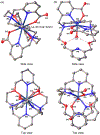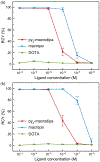Chelating Rare-Earth Metals (Ln3+) and 225Ac3+ with the Dual-Size-Selective Macrocyclic Ligand Py2-Macrodipa
- PMID: 35914099
- PMCID: PMC10933393
- DOI: 10.1021/acs.inorgchem.2c01998
Chelating Rare-Earth Metals (Ln3+) and 225Ac3+ with the Dual-Size-Selective Macrocyclic Ligand Py2-Macrodipa
Erratum in
-
Correction to Chelating Rare-Earth Metals (Ln3+) and 225Ac3+ with the Dual-Size-Selective Macrocyclic Ligand Py2-Macrodipa.Inorg Chem. 2022 Nov 7;61(44):17924-17925. doi: 10.1021/acs.inorgchem.2c03483. Epub 2022 Oct 25. Inorg Chem. 2022. PMID: 36282271 No abstract available.
Abstract
Radioisotopes of metallic elements, or radiometals, are widely employed in both therapeutic and diagnostic nuclear medicine. For this application, chelators that efficiently bind the radiometal of interest and form a stable metal-ligand complex with it are required. Toward the development of new chelators for nuclear medicine, we recently reported a novel class of 18-membered macrocyclic chelators that is characterized by their ability to form stable complexes with both large and small rare-earth metals (Ln3+), a property referred to as dual size selectivity. A specific chelator in this class called py-macrodipa, which contains one pyridyl group within its macrocyclic core, was established as a promising candidate for 135La3+, 213Bi3+, and 44Sc3+ chelation. Building upon this prior work, here we report the synthesis and characterization of a new chelator called py2-macrodipa with two pyridyl units fused into the macrocyclic backbone. Its coordination chemistry with the Ln3+ series was investigated by NMR spectroscopy, X-ray crystallography, density functional theory (DFT) calculations, analytical titrations, and transchelation assays. These studies reveal that py2-macrodipa retains the expected dual size selectivity and possesses an enhanced thermodynamic affinity for all Ln3+ compared to py-macrodipa. By contrast, the kinetic stability of Ln3+ complexes with py2-macrodipa is only improved for the light, large Ln3+ ions. Based upon these observations, we further assessed the suitability of py2-macrodipa for use with 225Ac3+, a large radiometal with valuable properties for targeted α therapy. Radiolabeling and stability studies revealed py2-macrodipa to efficiently incorporate 225Ac3+ and to form a complex that is inert in human serum over 3 weeks. Although py2-macrodipa does not surpass the state-of-the-art chelator macropa for 225Ac3+ chelation, it does provide another effective 225Ac3+ chelator. These studies shed light on the fundamental coordination chemistry of the Ln3+ series and may inspire future chelator design efforts.
Figures









Similar articles
-
Chelation of [111In]In3+ with the dual-size-selective macrocycles py-macrodipa and py2-macrodipa.Dalton Trans. 2024 Sep 10;53(35):14634-14647. doi: 10.1039/d4dt02146k. Dalton Trans. 2024. PMID: 39163366
-
Py-Macrodipa: A Janus Chelator Capable of Binding Medicinally Relevant Rare-Earth Radiometals of Disparate Sizes.J Am Chem Soc. 2021 Jul 14;143(27):10429-10440. doi: 10.1021/jacs.1c05339. Epub 2021 Jun 30. J Am Chem Soc. 2021. PMID: 34190542 Free PMC article.
-
Advancing Chelation Strategies for Large Metal Ions for Nuclear Medicine Applications.Acc Chem Res. 2022 Mar 15;55(6):904-915. doi: 10.1021/acs.accounts.2c00003. Epub 2022 Mar 1. Acc Chem Res. 2022. PMID: 35230803 Free PMC article.
-
Emerging chelators for nuclear imaging.Curr Opin Chem Biol. 2021 Aug;63:152-162. doi: 10.1016/j.cbpa.2021.03.001. Epub 2021 May 26. Curr Opin Chem Biol. 2021. PMID: 34051509 Review.
-
Matching chelators to radiometals for radiopharmaceuticals.Chem Soc Rev. 2014 Jan 7;43(1):260-90. doi: 10.1039/c3cs60304k. Epub 2013 Oct 30. Chem Soc Rev. 2014. PMID: 24173525 Review.
Cited by
-
225Ac-Labeled Somatostatin Analogs in the Management of Neuroendocrine Tumors: From Radiochemistry to Clinic.Pharmaceutics. 2023 Mar 24;15(4):1051. doi: 10.3390/pharmaceutics15041051. Pharmaceutics. 2023. PMID: 37111537 Free PMC article. Review.
-
18-membered macrocycle appended on resin for selective rare earth element extraction and separation.Commun Chem. 2025 Jun 5;8(1):176. doi: 10.1038/s42004-025-01565-4. Commun Chem. 2025. PMID: 40473929 Free PMC article.
-
Extraordinary kinetic inertness of lanthanide(iii) complexes of pyridine-rigidified 18-membered hexaazamacrocycles with four acetate pendant arms.Chem Sci. 2025 May 30;16(27):12558-12567. doi: 10.1039/d5sc01893e. eCollection 2025 Jul 10. Chem Sci. 2025. PMID: 40510332 Free PMC article.
-
Charting the coordinative landscape of the 18F-Sc/44Sc/177Lu triad with the tri-aza-cyclononane (tacn) scaffold.Chem Sci. 2024 Oct 3;15(43):17927-36. doi: 10.1039/d4sc04735d. Online ahead of print. Chem Sci. 2024. PMID: 39397825 Free PMC article.
-
Chelation of [111In]In3+ with the dual-size-selective macrocycles py-macrodipa and py2-macrodipa.Dalton Trans. 2024 Sep 10;53(35):14634-14647. doi: 10.1039/d4dt02146k. Dalton Trans. 2024. PMID: 39163366
References
-
- Radiopharmaceutical Chemistry; Lewis JS, Windhorst AD, Zeglis BM, Eds.; Springer Nature Switzerland AG: Cham, Switzerland, 2019.
-
- Dondi M; Kashyap R; Paez D; Pascual T; Zaknun J; Mut Bastos F; Pynda Y Trends in Nuclear Medicine in Developing Countries. J. Nucl. Med 2011, 52, 16S–23S. - PubMed
-
- Delbeke D; Segall GM Status of and Trends in Nuclear Medicine in the United States. J. Nucl. Med 2011, 52, 24S–28S. - PubMed
-
- Kramer-Marek G; Capala J The Role of Nuclear Medicine in Modern Therapy of Cancer. Tumor Biol. 2012, 33, 629–640. - PubMed

